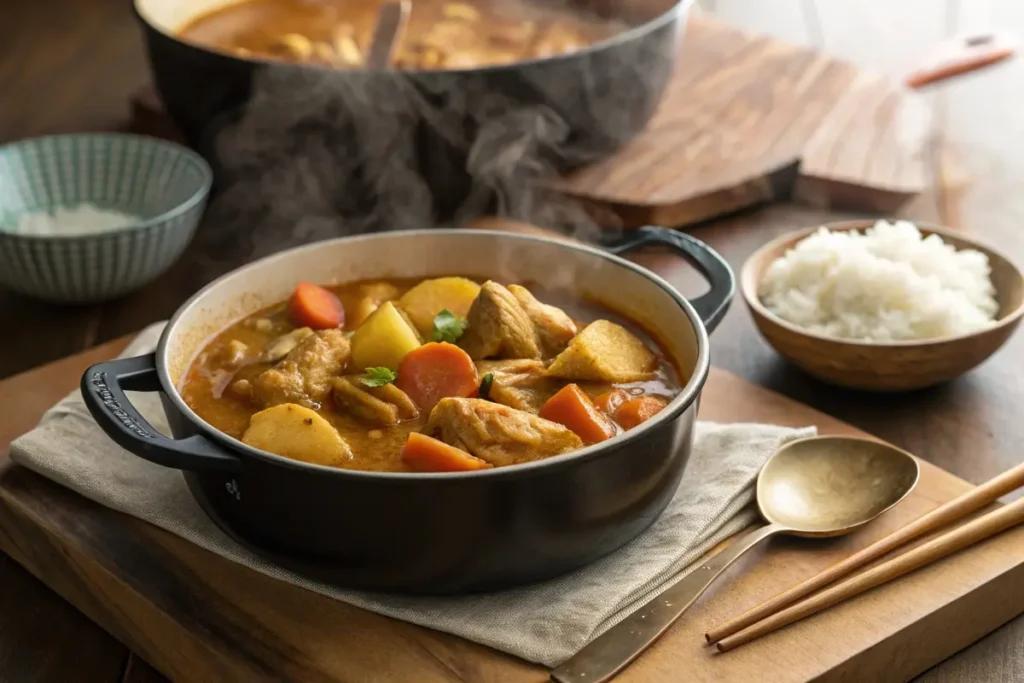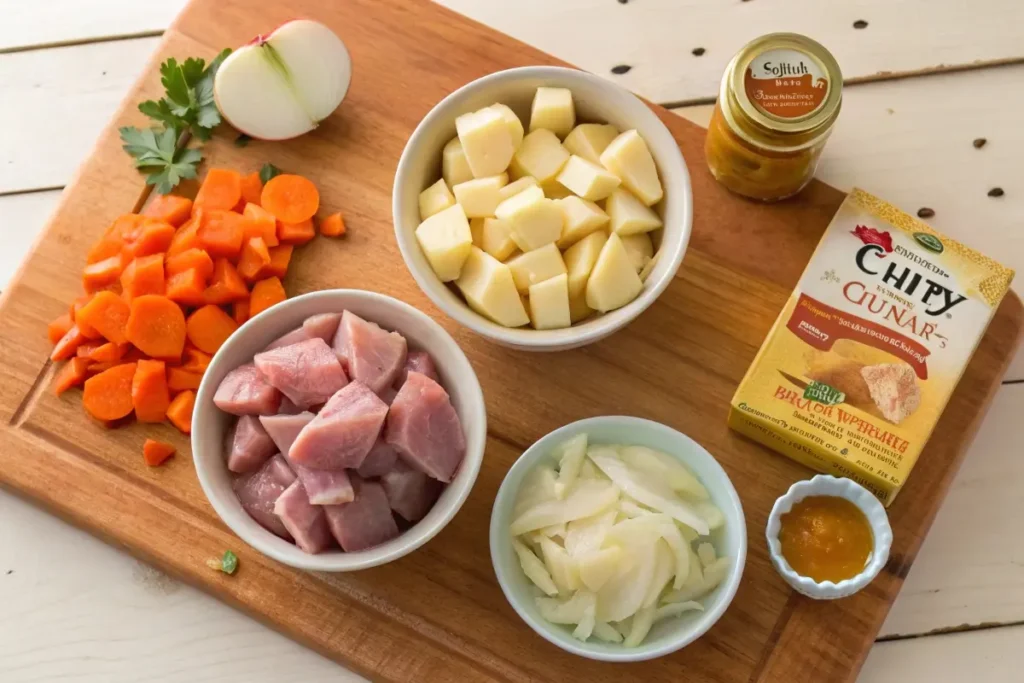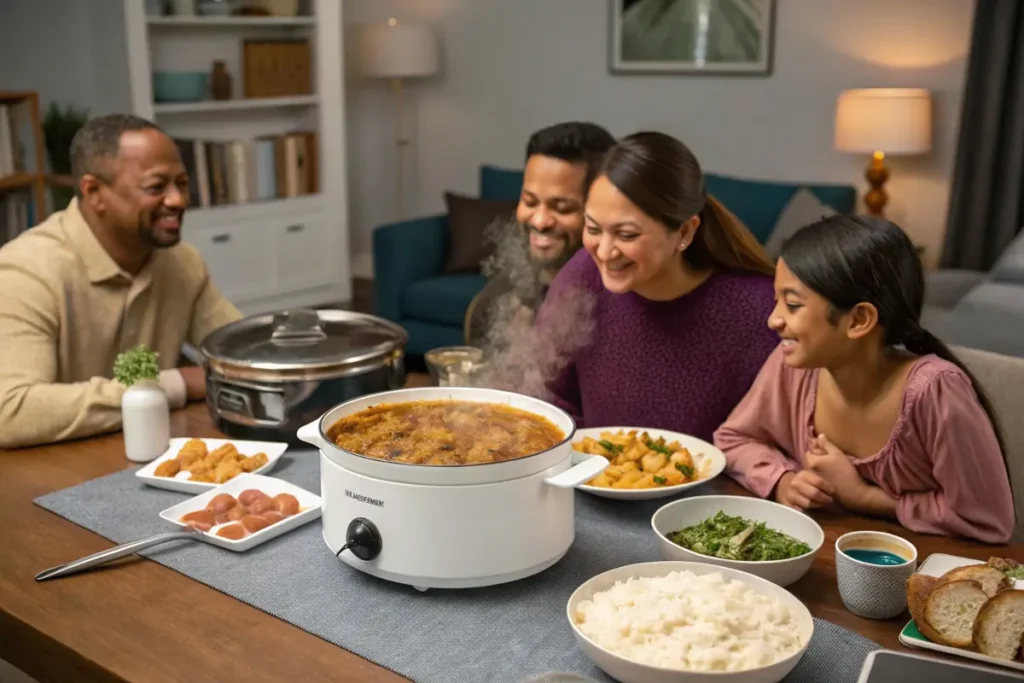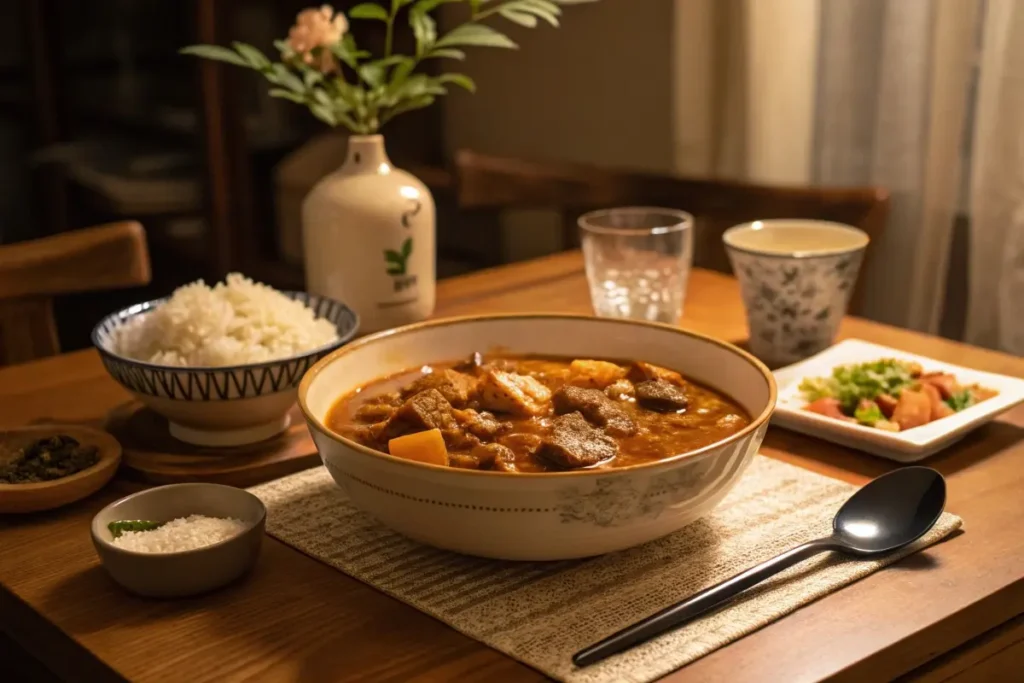If you’re craving a comforting meal that’s both nourishing and adaptable, a japanese chicken curry recipe might be exactly what you need. Within the first aromatic whiff, you’ll notice how this style of curry stands apart from others: it’s subtly sweet, mildly spicy, and thick with onions, carrots, and potatoes. You may wonder, How to deepen Japanese curry flavor? or Does coconut milk go in Japanese curry? Throughout this article, we’ll answer these questions and delve into every nuance of preparing an authentic yet customizable Japanese chicken curry. Whether you’re curious about the difference between Japanese curry and curry from other regions, or want to discover what is traditional Japanese curry made of, you’ll find all the insights here.
For more unique Japanese dishes, check out our Japanese Recipes hub, where you can explore everything from soups and sauces to full-course meals. Now, let’s embark on this flavorful journey to learn how to make your own signature Japanese chicken curry.

Understanding the Essence of Japanese Chicken Curry
Japanese chicken curry is often associated with comfort—think of it as the Japanese version of a cozy stew. While curry japanese rice combination might remind you of other Asian curries, the Japanese approach is unique in its flavor balance and consistency.
1. Milder, Sweeter Profile
Unlike some Indian or Thai curries, japanese curry recipe frequently leans sweet and mild rather than fiery. Brands of curry roux blocks—sold in supermarkets—offer spice levels ranging from mild to extra hot. Even at higher spice levels, the heat is generally more subdued, allowing subtle sweetness and savoriness to come through.
2. Thick Sauce
The texture is noticeably thicker compared to many South or Southeast Asian counterparts. This thickness comes from a roux made of fats and flour, either store-bought in block form or homemade. This style of curry clings to the ingredients, forming a hearty, gravy-like sauce.
3. Comfort Food Universally Loved
Japanese chicken curry is a staple in both home kitchens and casual eateries. Many students recall school lunches featuring a plate of rice topped with creamy curry and crisp pickles (fukujinzuke), illustrating how integral this dish is in everyday life. Much like how Western households might have a default stew or pasta, curry rice is a go-to for many Japanese families.
4. Key Ingredients
Common vegetables include:
- Carrots: Add subtle sweetness.
- Potatoes: Provide heft and creaminess.
- Onions: Deliver a naturally sweet note when caramelized.
- Chicken: Typically boneless thighs or breast, but thighs are favored for extra juiciness and flavor.
5. Customization Potential
- Spice and Sweetness: Adjust using different curry roux brands or by adding honey, grated apples, or chili powder. This helps address How to deepen Japanese curry flavor?—integrating fruit or extra spices can enrich it.
- Protein Variants: Swap out chicken for beef, pork, or tofu.
- Coconut Milk?: While not traditionally used in Japanese curry, some cooks add it for creaminess. Does coconut milk go in Japanese curry? It’s optional, but can offer a Southeast Asian twist.
For more chicken-based inspirations, see our Japanese Chicken Fried Rice Recipe to explore additional ways to incorporate poultry into a flavorful Japanese dish. From mild to moderately spicy, Japanese chicken curry is flexible enough to fit various palates while remaining distinctly comforting.

Step-by-Step: How to Make Japanese Chicken Curry
Below is a classic recipe japanese chicken curry approach, ensuring tender chicken and a well-rounded sauce. You can modify it to suit your spice preference or dietary needs.
Ingredients (Serves 4-6)
- Chicken: 1.5 lbs (approx. 700g) of boneless, skinless chicken thighs or breasts, cut into bite-sized chunks
- Vegetables: 2 medium onions (thinly sliced), 2 carrots (peeled and chopped), 2 potatoes (peeled and cubed)
- Oil or Butter: 2 tablespoons for sautéing
- Garlic & Ginger (optional): 1 clove of garlic minced, 1 teaspoon grated ginger
- Curry Roux Block: 4-5 cubes from a standard box (adjust based on brand/spice level)
- Broth or Water: ~3 cups (chicken or vegetable stock recommended)
- Sweeteners (optional): 1 tablespoon honey or grated apple to deepen flavor
- Salt & Pepper: to taste
Method
- Sauté the Chicken: Season chicken pieces with salt and pepper. Heat oil or butter in a large pot over medium-high heat. Brown the chicken until lightly golden, then set aside.
- Caramelize the Onions: In the same pot, add sliced onions. Cook over medium heat until they become soft and slightly golden. This step adds sweetness and complexity. If using garlic and ginger, add them now, stirring for about 1 minute.
- Combine Vegetables: Return the chicken to the pot along with carrots and potatoes. Sauté briefly for 2-3 minutes.
- Add Broth: Pour in about 3 cups of chicken or vegetable stock. Increase heat to bring it to a boil, then lower to simmer. Skim off any foam that appears on the surface.
- Incorporate Roux: Once vegetables are partially cooked (about 15-20 minutes), turn off the heat. Stir in curry roux cubes a piece at a time, allowing them to dissolve completely.
- Simmer & Thicken: Turn the heat back on low, letting the curry simmer gently. Add honey or grated apple if desired for extra sweetness. Cook until the sauce thickens, about 10-15 more minutes.
- Taste & Adjust: Season with salt or pepper if needed. If you enjoy spicier curry, a dash of chili powder or cayenne can elevate the heat.
- Serve: Ladle your curry over steamed rice. Garnish with chopped green onions or pickled ginger for a bright finish.
Cooking Tips
- Slow Cooking: For a more tender bite, consider a slow cooker approach. Brown the chicken and onions first, then let everything stew on low for 6-8 hours.
- Texture Control: If it’s too thick, add more water or stock. If it’s too thin, simmer uncovered to reduce.
- Oil Choices: Vegetable oil or butter are common; for a slightly nutty aroma, try a tablespoon of sesame oil.
For additional inspiration on Japanese comfort foods, check out our Japanese Curry Recipe One Piece for another variation that emphasizes unique regional flavors. Each step in your curry-making process—browning meats, building aromatic depth, slowly simmering—ensures a robust, satisfying dish that’s as comforting as it is flavorful.

Enhancing and Customizing Your Curry
A japanese chicken curry recipe can serve as a foundation for countless variations. Here are ways to amplify its taste, tailor it to different dietary preferences, and keep your curry game exciting.
1. Deepening Flavor
- Caramelized Onions: Cooking onions slowly until golden brings out natural sweetness.
- Fruit Factor: If you’re curious How to deepen Japanese curry flavor? grated apples, pears, or even mashed bananas can add sweetness and mild complexity.
- Dark Chocolate or Coffee: Some cooks stir in a small piece of dark chocolate or a spoonful of coffee for slight bitterness, balancing the sauce’s sweetness.
- Mirin or Sake: A splash can impart subtle umami and lighten the sauce.
2. Adjusting Spice and Consistency
- Heat Control: Japanese curry is typically mild, but you can add chili powder, fresh chili, or shichimi togarashi for more heat.
- Thickness: If you prefer a soupier curry, add more broth. For a stew-like consistency, let it simmer uncovered to reduce.
3. Does Coconut Milk Go in Japanese Curry?
Traditionally, japanese curry rice recipe doesn’t call for coconut milk. However, some modern renditions include it for a richer mouthfeel, leaning closer to Thai curries. If you enjoy creaminess, coconut milk or even plain yogurt can be stirred in during the final simmer.
4. Alternative Proteins and Vegetables
- Protein Swaps: Chicken thighs are classic, but you can switch to beef chuck roast or pork shoulder if you want a different meat. (Check out our Japanese Curry Recipe One Piece for a unique spin.) For a vegetarian take, tofu or mushrooms can provide heartiness.
- Vegetarian or Vegan: Skip chicken, use vegetable broth, and choose a roux brand without animal products. Our Vegan Japanese Recipes section can guide you on plant-based alternatives.
- Additional Veggies: Eggplant, bell peppers, or zucchini can add color and nutrients.
5. Serving Suggestions
- Classic Rice Pairing: Usually served with short-grain white rice. For a healthier spin, opt for brown rice or mixed grains.
- Toppings: Fukujinzuke (pickled daikon) or rakkyo (pickled shallots) provide tangy contrast.
- Side Dishes: A crisp salad with ginger dressing or a simple miso soup complements the curry’s hearty richness.
6. Storage and Freezing
- Reheating: Japanese chicken curry often tastes better the next day as flavors meld further. Reheat gently on the stove or microwave.
- Freezing: The sauce can be frozen in portions for up to a month, though potato texture may slightly change upon thawing.
For broader meal ideas, consider our Healthy Japanese Recipes which feature lighter sides and creative ways to incorporate vegetables. Whether you embrace a sweet-and-mild or spicy-and-bold approach, Japanese chicken curry’s adaptability ensures there’s always room to experiment and savor new layers of flavor.

History/Context
While curry is often associated with South Asia, Japan’s adoption and adaptation of curry tells a fascinating story of cultural exchange and evolution. To fully appreciate japanese chicken curry recipe, consider how the dish traversed continents and found a cherished place in Japanese households.
From the British Navy to Japanese Kitchens
Curry first arrived in Japan during the late 19th century, introduced indirectly via the British Royal Navy. The British had adapted Indian curry to suit milder palates, forming a roux-based sauce. Japanese naval forces soon discovered that stew-like curry, packed with vegetables and thick sauce, was easy to serve at sea. This navy usage set the stage for widespread acceptance of curry across the nation.
Domestic Popularity Boom
By the early 20th century, curry was no longer limited to naval canteens. Street vendors and small diners recognized its potential to feed people quickly and inexpensively. The concept of kare raisu (curry rice) steadily grew in popularity, eventually appearing in school lunches and home kitchens. As a result, children grew up with curry as a frequent meal—both convenient and comforting.
Post-War Innovations
After World War II, Japan’s economy boomed, and food manufacturers developed commercial curry roux blocks, simplifying the process for home cooks. Suddenly, making curry at home involved just browning onions, meat, and vegetables, then adding water and these dissolvable blocks. Japanese curry rice recipe soared in popularity even more, as more families integrated it into their weekly meal rotations.
Chicken’s Role
While beef or pork curries are also common, chicken gained traction for being less expensive and versatile. Japanese chicken curry recipe quickly found favor among households seeking a lighter protein choice without sacrificing flavor. Chicken also cooks faster than beef, meeting the time constraints of busy families.
Modern Twists and Global Reach
In contemporary Japan, curry’s variations are seemingly endless: spicy versions, coconut-based fusions, or even cheese curry. Outside Japan, restaurants serve japanese curry rice recipe as a nostalgic staple for expats and an exciting discovery for newcomers. Dishes like katsu curry (curry with a breaded pork cutlet) or curry udon further illustrate how Japan’s curry culture keeps expanding.
If you enjoy tracing the lineage of other iconic Japanese dishes, our Japanese Steak Recipe provides a look at how Western influences shaped a local favorite. Today’s Japanese chicken curry stands as a testament to how external cultural elements can blend seamlessly with domestic tastes, culminating in a dish that’s at once foreign in origin but deeply rooted in Japanese culinary identity.

Practical Examples/Use Cases
Knowing how to make a japanese chicken curry recipe is one thing; adapting it to daily life is another. Whether you’re cooking for a family or prepping for an event, these examples show how flexible Japanese chicken curry can be.
1. Weeknight Family Dinner
- Scenario: You have limited time, but want a comforting meal.
- Approach: Chop vegetables and chicken in the morning. After work, sauté everything, add store-bought curry roux, and simmer for about 25 minutes. Serve with rice and a side salad.
- Benefit: Quick, robust flavor with minimal effort. Satisfies diverse palates, including kids who prefer milder tastes.
2. Meal Prep for the Week
- Scenario: You’re planning lunches to avoid fast-food options.
- Approach: Make a large batch of curry on Sunday. Portion it into individual containers along with cooked rice. Refrigerate or freeze for up to a week.
- Benefit: Reheat in minutes, letting you enjoy a homemade, hearty meal with minimal fuss during busy weekdays.
3. Potluck or Party Dish
- Scenario: You need a crowd-pleaser for a casual gathering.
- Approach: Prepare a big pot of curry and keep it warm in a slow cooker or insulated container. Provide small cups or bowls of rice for guests.
- Benefit: Curry’s thick consistency and universal appeal make it easy to transport and serve. It also stands out among standard potluck dishes.
4. Comfort for Cold Days
- Scenario: It’s chilly outside, and you want something warming.
- Approach: Add extra vegetables like mushrooms or sweet potatoes, letting them simmer for a slightly longer duration. A swirl of coconut milk can add creaminess.
- Benefit: A cozy, rich dish that’s perfect for snowy evenings or rainy afternoons, with the comforting aroma filling your home.
For another comforting Japanese meal, peruse our Japanese Corn Recipe for a sweet, hearty side that pairs surprisingly well with the savory notes of curry. From quick family dinners to large gatherings, Japanese chicken curry proves its versatility and universal appeal, making it a mainstay in many households around the world.

FAQs
Below are the most common questions about japanese chicken curry recipe, offering concise insights into flavor, ingredients, and techniques for optimal results.
- How to deepen Japanese curry flavor?
You can caramelize onions longer, add grated apples or honey, or incorporate a small piece of dark chocolate. Simmering for an extra 10-15 minutes can also enrich the sauce. This layered approach often yields a more complex, satisfying taste. - Does coconut milk go in Japanese curry?
Traditionally, no. Japanese curry typically relies on a roux-based sauce without coconut milk. However, modern adaptations sometimes include coconut milk for added creaminess or an exotic twist. Feel free to try it if you enjoy richer textures. - What is the difference between Japanese curry and curry from other regions?
Japanese curry generally tastes milder, sweeter, and thicker, thanks to the flour- or roux-based sauce. In contrast, Indian or Thai curries often use more intense spices or coconut milk. Japanese curries also incorporate vegetables like potatoes, carrots, and onions in almost every variant. - What is traditional Japanese curry made of?
Typically, it includes a protein (chicken, beef, or pork), onions, carrots, potatoes, and a roux-based sauce that blends sweet, savory, and mildly spicy flavors. Rice is the standard accompaniment. Some recipes add fruit for sweetness or chili powder for a subtle kick. - How do I store leftovers?
Let the curry cool, then transfer it to an airtight container and refrigerate for up to 3-4 days. Reheat gently on the stove or in the microwave. Potatoes may change texture slightly, but the flavor often improves over time. - Can I make a healthier version?
Absolutely. Use skinless chicken breast, reduce the roux or choose a low-fat brand, and add extra vegetables. Consider skipping sweeteners like honey. For more health-focused ideas, check out our Healthy Japanese Recipes to find alternative cooking methods and ingredient choices. - Do I need specialized equipment or saucepans?
Not at all. A sturdy pot or Dutch oven works fine for simmering. A slow cooker can simplify the process if you’re short on time. Just remember to brown your chicken and onions beforehand for maximum flavor.

Conclusion
A japanese chicken curry recipe delivers an excellent balance of savory, mildly sweet, and warmly spiced flavors—perfect for family dinners or cozy solo meals. By selecting fresh ingredients, patiently browning onions, and blending sweeteners like honey or grated apples, you’ll achieve a curry that’s both comforting and surprisingly versatile. Whether you prefer thick, stew-like consistency or want a thinner, more soup-style approach, each choice helps tailor the dish to your personal taste.
Feel free to experiment with coconut milk or extra chili if you crave twists beyond the traditional. If you’re seeking more ways to celebrate Japanese cuisine, check out our Japanese Curry Recipe One Piece for an anime-inspired version, or dig deeper into other culinary delights like katsu curry and vegetarian curry options. No matter how you adapt it, the spirit of Japanese curry remains grounded in accessibility and warmth—a crowd-pleasing staple enjoyed everywhere from school cafeterias to fine-dining establishments.
Ready to start cooking? Gather your vegetables, pick your favorite protein, and put that curry roux to good use. With each pot, you’ll discover new ways to refine the flavor, creating a signature style that keeps friends and family asking for seconds. Enjoy!

